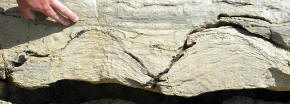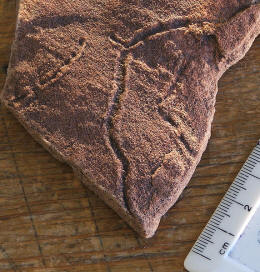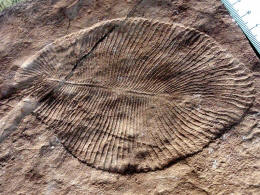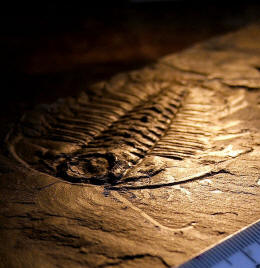Evidence of Animals 1 Billion Years Ago
Changes in the abundance and diversity of some types of fossil have been
interpreted as evidence for "attacks" by animals or other organisms.
Stromatolites (picture at right), stubby pillars built bycolonies of
microorganisms, are a major constituent of the fossil record from about
, but their abundance and diversity
declined steeply after about
. This decline has been attributed to
disruption by grazing and burrowing animals.
evidence for "attacks" by animals or other organisms.
Stromatolites (picture at right), stubby pillars built bycolonies of
microorganisms, are a major constituent of the fossil record from about
, but their abundance and diversity
declined steeply after about
. This decline has been attributed to
disruption by grazing and burrowing animals.
Precambrian marine diversity was dominated by small fossils known as acritarchs. This term describes almost any small organic walled fossil–from the egg cases of small metazoans to resting cysts of many different kinds of green algae. After appearing around , acritarchs underwent a boom around , increasing in abundance, diversity, size, complexity of shape and especially size and number of spines. Their increasingly spiny forms in the last 1 billion years may indicate an increased need for defense against predation. Other groups of small organisms from the Neoproterozoic era also show signs of anti-predator defenses. A consideration of taxon longevity appears to support an increase in predation pressure around this time, However, in general, the rate of evolution in the Precambrian was very slow, with many cyanobacterial species persisting unchanged for billions of years.
If these predatory organisms really were metazoans, this means that Cambrian animals did not appear "from no-where" at the base of the Cambrian; their predecessors had existed for hundreds of millions of years.
Fossils of the Doushantuo Formation
The 580 million year old Doushantuo formation harbours microscopic fossils which may represent early bilaterians. Some have been described as animal embryos and eggs, although some of these may represent the remains of giant bacteria. Another fossil, Vernanimalcula, has been interpreted as a coelomate bilaterian, but may simply be an infilled bubble.
These fossils form the earliest hard-and-fast evidence of animals, as opposed to other predators.
Burrows
 |
| An Ediacaran trace fossil, made when an organism burrowed below a microbial mat. (Picture Source) |
The traces of organisms moving on and directly underneath the microbial mats that covered the Ediacaran sea floor are preserved from the Ediacaran period, about 565 million years ago. They were probably made by organisms resembling earthworms in shape, size, and how they moved. The burrow-makers have never been found preserved, but because they would need a head and a tail, the burrowers probably had bilateral symmetry – which would in all probability make them bilaterian animals. They fed above the sediment surface, but were forced to burrow to avoid predators.
Around the start of the Cambrian (about 542 million years ago) many new types of traces first appear, including well-known vertical burrows such as Diplocraterion and Skolithos, and traces normally attributed to arthropods, such as Cruziana and Rusophycus. The vertical burrows indicate that worm-like animals acquired new behaviours, and possibly new physical capabilities. Some Cambrian trace fossils indicate that their makers possessed hard exoskeletons, although there were not necessarily mineralised.
Burrows provide firm evidence of complex organisms; they are also much more readily preserved than body fossils, to the extent that the absence of trace fossils has been used to imply the genuine absence of large, motile bottom-dwelling organisms. They provide a further line of evidence to show that the Cambrian explosion represents a real diversification, and is not a preservational artefact.
Indeed, as burrowing became established, it allowed an explosion of its own, for as burrowers disturbed the sea floor, they aerated it, mixing oxygen into the toxic muds. This made the bottom sediments more hospitable, and allowed a wider range of organisms to inhabit them – creating new niches and the scope for higher diversity.
(For more, see Cambrian substrate revolution)
Ediacaran Organisms
At the start of the Ediacaran period, much of the acritarch fauna, which had
 |
| Dickinsonia costata, an Ediacaran organism of unknown affinity, with a quilted appearance. Picture Source) |
Many of these organisms were quite unlike anything that appeared before or since, resembling discs, mud-filled bags, or quilted mattresses – one palæontologist proposed that the strangest organisms should be classified as a separate kingdom, Vendozoa.
At least some may have been early forms of the phyla at the heart of the "Cambrian explosion" debate, having been interpreted as early molluscs (Kimberella), echinoderms (Arkarua); and arthropods (Spriggina, Parvancorina). There is still debate about the classification of these specimens, mainly because the diagnostic features which allow taxonomists to classify more recent organisms, such as similarities to living organisms, are generally absent in the Ediacarans. However there seems little doubt that Kimberella was at least a triploblastic bilaterian animal. These organisms are central to the debate about how abrupt the Cambrian explosion was. If some were early members of the animal phyla seen today, the "explosion" looks a lot less sudden than if all these organisms represent an unrelated "experiment", and were replaced by the animal kingdom fairly soon thereafter (40M years is "soon" by evolutionary and geological standards).
Ediacaran Skeletalization
Oldest Ediacaran skeletal fossils are organic chitinous tubes sabelliditids (e.g. Saarina, later Sabellidites) which appeared simultaneously with Dickinsonia, Kimberella, Parvancorina and others. It is long, thin- or thick-walled, cylindrical, and commonly flattened with a wrinkled surface tube. They were commonly compared with tubes of sedentary polychaetes or other organisms.
Fossils of the Cloudina, Namacalathus, Sinotubulites and a dozen more of the other organisms with mineral skeletons have been found in sediments formed near the end of the Ediacaran period from 549 to 542 million years ago. Although they are as hard to classify as most other Ediacaran organisms, they are important in two other ways. First, they are the earliest known calcifying organisms (organisms that built shells out of calcium carbonate). Some Cloudina fossils show small holes in shells, while Sinotubulites fossils found in the same locations do not. Some researchers suggested that the holes are evidence of borings by predators that were sufficiently advanced to penetrate shells; these predators found Cloudina a more inviting target than Sinotubulites. A possible "evolutionary arms race" between predators and prey is one of the most promising components of theories that attempt to explain the Cambrian explosion.
Moreover, in the Siberia several anabaritid species, the members of the Cambrian SSF, are found in Ediacaran beds, including together with Cloudina fossil.
Cambrian Life
Small Shelly Fauna
Fossils known as “small shelly fauna” have been found in many parts on the world, and date from just before the Cambrian to about 10 million years after the start of the Cambrian. These are a very mixed collection of fossils: spines, sclerites (armor plates), tubes, archeocyathids (sponge-like animals) and small shells very like those of brachiopods and snail-like molluscs – but all tiny, mostly 1 to 2 mm long.
While small, these fossils are far more common than complete fossils of the organisms that produced them; crucially, they cover the window from the start of the Cambrian to the first lagerstatten: a period of time that is otherwise lacking in fossils. Hence they supplement the conventional fossil record, and allow the fossil ranges of many groups to be extended.
Early Cambrian trilobites and echinoderms
 |
| A fossilized trilobite, an ancient type of arthropod. This specimen, from the Burgess shale, preserves "soft parts" – the antennae and legs. (Picture Source) |
The earliest Cambrian trilobite fossils are about 530 million years old, but the class was already quite diverse and worldwide, suggesting that they had been around for quite some time.
The earliest generally-accepted echinoderm fossils appeared a little bit later, in the Late Atdabanian; unlike modern echinoderms, these early Cambrian echinoderms were not all radially symmetrical.
These provide firm data points for the "end" of the explosion, or at least indications that the crown groups of modern phyla were represented.
Burgess shale type faunas
The Burgess shale and similar lagerstatten preserve the soft parts of organisms, which provides a wealth of data to aid in the classification of enigmatic fossils. It often preserved complete specimens of organisms only otherwise known from dispersed parts, such as loose scales or isolated mouthparts. Further, the majority of organisms and taxa in these horizons are entirely soft bodied – hence absent from the rest of the fossil record. Since a large part of the ecosystem is preserved, the ecology of the community can also be tentatively reconstructed. However, the assemblages may represent a "museum": a deep water ecosystem that is evolutionarily "behind" the rapidly diversifying faunas of shallower waters.
Because the lagerstatten provide a mode and quality of preservation that's virtually absent outside of the Cambrian, lots of organisms appear completely different to anything known from the conventional fossil record. This led early workers in the field to attempt to shoehorn the organisms into extant phyla; the shortcomings of this approach led them to erect a multitude of new phyla to accommodate all the oddballs. It has since been realised that most oddballs diverged from lineages before they established the phyla we know today – slightly different designs, which were fated to perish rather than flourish into phyla, as their cousin lineages did.
The preservational mode is rare in the preceding Ediacaran period, but those assemblages known show no trace of animal life – perhaps implying a genuine absence of macroscopic metazoans.
Early Cambrian Crustaceans
Crustaceans, one of the four great modern groups of arthropods, are very rare throughout the Cambrian. Convincing crustaceans were once thought to be common in Burgess shale-type biotas, but none of these individuals can be shown to fall into the crown group of "true crustaceans". The Cambrian record of crown group crustaceans comes from microfossils. The Swedish Orsten horizons contain later Cambrian crustacea, but only organisms smaller than 2 mm are preserved. This restricts the data set to juveniles and miniaturised adults.
A more informative data source is the organic microfossils of the Mount Cap formation, Canada. This late Early Cambrian assemblage (510 to 515 million years ago) consists of microscopic fragments of arthropods' cuticle, which is left behind when the rock is dissolved with a strong acid. The diversity of this assemblage is similar to that of modern crustacean faunas. Most interestingly, analysis of fragments of feeding machinery found in the formation shows that it was adapted to feed in a very precise and refined fashion. This contrasts with most other early Cambrian arthropods, which fed messily by shovelling anything they could get their feeding appendages on into their mouths. This sophisticated and specialised feeding machinery belonged to a large (~30 cm) organism, and would have provided great potential for diversification: specialised feeding apparatus allows a number of different approaches to feeding and development, and creates a number of different approaches to avoid being eaten.
Early Ordovician Radiation
After a mass extinction at the Cambrian-Ordovician boundary, another radiation occurred, which established the taxa which would dominate the Palaeozoic.
A new phylum, the Bryozoa, is first observed after this Ordovician radiation; the total number of orders doubled, and families tripled, increasing marine diversity to levels typical of the Palaeozoic, and disparity to levels approximately equivalent to today's.
![]()
Return to the Old Earth Ministries Online Earth History Curriculum homepage.
![]()
Source: Cambrian Explosion